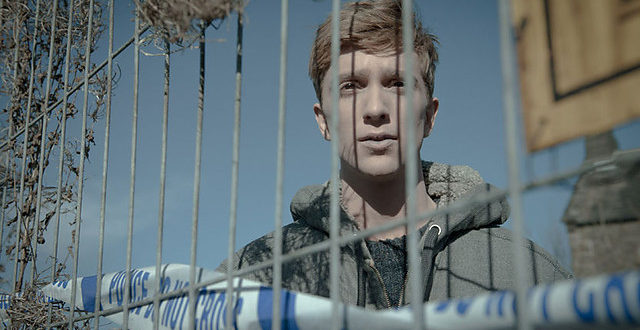What if the zombie apocalypse came and, instead of the human race being reduced to rubble, they rallied and survived mostly intact? What if, instead of a shot to the brain being the only solution for the undead, there was treatment, a daily injection that could return the mind to a pre-zombie state? This is the scenario offered by In the Flesh.
In the Flesh is a BAFTA award-winning BBC Three supernatural drama series written and created by Dominic Mitchell and starring Luke Newberry. The brief backstory is this: following the zombies’ arrival in a 2009 event called “The Rising,” scientists came up with a way to manage the condition. Much like HIV/AIDS, the condition of the Rotters (as they are called in England where the show is set) is conceived as a virus and controlled by drugs. The treatment allows those afflicted with the Partially Deceased Syndrome to regain their minds and personalities.
This brings us to Kieren Walker (Luke Newberry: Frankenstein’s Army 2013), who is now and forever 18 years old and just another Rotter being processed out of a hospital in England. In a scheme that echoes the absurdities of today’s medical bureaucracies, the Rotters are given group therapy sessions along with their injections. As he’s asked to talk out his feelings, Kieren is wracked with guilt over the memory of his last kill, a teenage girl he attacked while she was raiding a supermarket for candy and snack bars.

After this partially effective treatment, Kieren is given a heavy dose of cover-up for his skin, some contact lenses, and a pamphlet about his condition. Then he’s sent home with his parents. Home is the microscopic town of Roarton, which is little more than a church, a bar and a supermarket. It’s the kind of place where sheep outnumber people and your neighbors regularly peer into your windows. Even before The Rising, Roarton wasn’t exactly a welcoming community for people a little bit different and the townspeople haven’t started singing, “Kumbaya” now that the Rotters are being reintegrated back into society.
This angle is hardly new. George Romero famously used fear of zombiism to stand in for intolerance in his films. This is also the route taken by In the Flesh, with a welcome wrinkle. As Kieren explains at several points to his family, he wasn’t exactly popular among the town’s old guard while he was alive. While the show doesn’t press the point, it appears that Kieren’s sexuality was either ambiguous or perceived as deviant by his fellows. Now that he’s Partially Deceased and doesn’t seem all that interested in sex, the community has just found another reason to shun him. And so again, zombiism provides a way to view prejudice, rather than as a monstrosity per se.
The fearmongers here take up their old mission as the Human Volunteer Force, a group of survivalists who defended Roarton when the army failed to show up during The Rising. Now that the threat is mostly gone, the HVF still play dress up in their fatigues and armbands, going on patrols in the woods and demanding free drinks for life from the local pub. Hanging over the bar is a photo of a young girl in HVF garb posing next to two dead Rotters like a hunter next to her trophy bucks. This girl, the “Rambo of Roarton,” is Kieren’s sister, Jem (Harriet Caines), transformed by the loss of her brother.
Now, Jem’s ongoing aggitation complicates Kieren’s homecoming. Hardcore Rotter-killer Jem first refuses even to acknowledge her brother, calling him a “thing” and a “monster.” Slowly Kieren breaks through, and by the time he recalls how his brash little sister used to be so shy that she walked on her tiptoes everywhere, Jem’s sorrow over Kieren’s original death boils over in a burst of tears.
This reunion is only one of the show’s reflections of interpersonal relations in a non-Rotter world. In order not to upset anyone, Kieren has to pretend to eat at the dinner table, air-cutting his food with a fork and knife. An industry of in-home caregivers for Rotters has been created, not unlike the kind for humans suffering from disease or infirmity that leaves them unable to leave their residences.

Not all of these references are so convincing. A Rotter messiah issues proclamations over the internet and a pill circulates among the community that overrides the treatment for Rotters, turning them back into avid, flesh-eating monsters. If vampires on True Blood can sound cool because they’re essentially just awesome humans, a half-rotted zombie taking the Magneto defense by proclaiming Rotters to be humanity’s next evolution is less compelling. It’s easy to imagine someone wanting to be a sexy and powerful vampire, but, you know, who wants to be a shambling brain eater?
Viewed as a melodrama that happens to contain zombies, In the Flesh follows in the vein of other supernatural dramas from BBC like Being Human. While Kieren does contend with zombie-style gore, the show isn’t a kill-fest like The Walking Dead. Even as it raises the sort of questions that classic zombie once asked, In the Flesh also draws some perceptive connections to our own social and political contexts.
 PopHorror Let's Get Scared
PopHorror Let's Get Scared




